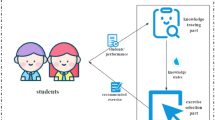Abstract
In educational practice, teachers often need to manually assemble an exercise collection as a class quiz or a homework assignment. A well-assembled exercise collection needs to have the proper difficulty index and discrimination index so that it can better develop students’ abilities. In this paper, we propose an exercise collection auto-assembling framework, in which a teacher provides the target values of difficulty and discrimination indices and a qualified exercise collection is automatically assembled. The framework consists of two stages. At the answer prediction stage, a knowledge tracing model is utilized to predict the students’ answers to unseen exercises based on their history interaction records. In addition, to better represent the exercises in the model, we propose exercise embeddings and design a pre-training approach. At the collection assembling stage, we propose a deep reinforcement learning model to assemble the required exercise collection effectively. Since the knowledge tracing model in the first stage has different confidences in the predicted answers, it is also taken into account in the objective. Experimental results show the effectiveness and efficiency of the proposed framework.
Similar content being viewed by others
References
Piech C, Bassen J, Huang J, Ganguli S, Sahami M, Guibas L J, Sohl-Dickstein J. Deep knowledge tracing. In Proc. the Annual Conference on Neural Information Processing Systems, Dec. 2015, pp.505-513.
Zhang J, Shi X, King I, Yeung D. Dynamic key-value memory networks for knowledge tracing. In Proc. the 26th International Conference on World Wide Web, Apr.2017, pp.765-774. https://doi.org/10.1145/3038912.3052580.
Su Y, Liu Q, Liu Q, Huang Z, Yin Y, Chen E, Ding C H Q, Wei S, Hu G. Exercise-enhanced sequential modeling for student performance prediction. In Proc. the 32nd AAAI Conference on Artificial Intelligence, Feb. 2018, pp.2435-2443. https://doi.org/10.1609/aaai.v32i1.11864.
Liu Q, Huang Z, Yin Y, Chen E, Xiong H, Su Y, Hu G. EKT: Exercise-aware knowledge tracing for student performance prediction. IEEE Trans. Knowl. Data Eng., 2021, 33(1): 100-115. https://doi.org/10.1109/TKDE.2019.2924374.
Chai C, Li G, Li J, Deng D, Feng J. Cost-effective crowd-sourced entity resolution: A partial-order approach. In Proc. the 2016 ACM International Conference on Management of Data, June 26-July 1, 2016, pp.969-984. https://doi.org/10.1145/2882903.2915252.
Li G, Chai C, Fan J, Weng X, Li J, Zheng Y, Li Y, Yu X, Zhang X, Yuan H. CDB: Optimizing queries with crowd-based selections and joins. In Proc. the 2017 ACM International Conference on Management of Data, May 2017, pp.1463-1478. https://doi.org/10.1145/3035918.3064036.
Chai C, Fan J, Li G. Incentive-based entity collection using crowdsourcing. In Proc. the 34th IEEE International Conference on Data Engineering, Apr. 2018, pp.341-352. https://doi.org/10.1109/ICDE.2018.00039.
Chai C, Cao L, Li G, Li J, Luo Y, Madden S. Human-in-the-loop outlier detection. In Proc. the 2020 ACM SIGMOD International Conference on Management of Data, Jun. 2019, pp.19-33. https://doi.org/10.1145/3318464.3389772.
Corbett A T, Anderson J R. Knowledge tracing: Modeling the acquisition of procedural knowledge. User Modeling and User-Adapted Interaction, 1994, 4(4): 253-278. https://doi.org/10.1007/BF01099821.
Nakagawa H, Iwasawa Y, Matsuo Y. Graph-based knowledge tracing: Modeling student proficiency using graph neural network. In Proc. the 2019 IEEE/WIC/ACM International Conference on Web Intelligence, Oct. 2019, pp.156-163. https://doi.org/10.1145/3350546.3352513.
Song X, Li J, Lei Q, Zhao We, Chen Y, Mian A. Bi-CLKT: Bi-graph contrastive learning based knowledge tracing. Knowl. Based Syst., 2022, 241: Article No. 108274. https://doi.org/10.1016/j.knosys.2022.108274.
Song X, Li J, Tang Y, Zhao T, Chen Y, Guan Z. JKT: A joint graph convolutional network based deep knowledge tracing. Information Sciences, 2021, 580: 510-523. https://doi.org/10.1016/j.ins.2021.08.100.
Xue G, Zhong M, Li J, Chen J, Zhai C, Kong R. Dynamic network embedding survey. Neurocomputing, 2022, 472: 212-223. https://doi.org/10.1016/j.neucom.2021.03.138.
Watkins C J C H, Dayan P. Q-learning. Machine Learning, 1992, 8(3): 279-292. https://doi.org/10.1007/BF00992698.
Chai C, Wang J, Luo Y, Niu Z, Li G. Data management for machine learning: A survey. IEEE Transactions on Knowledge and Data Engineering. https://doi.org/10.1109/TKDE.2022.3148237.
Chai C, Liu J, Tang N, Li G, Luo Y. Selective data acquisition in the wild for model charging. Proceedings of the VLDB Endowment, 2022, 15(7): 1466-1478. https://doi.org/10.14778/3523210.3523223.
Liu J, Chai C, Luo Y, Lou Y, Feng J, Tang N. Feature augmentation with reinforcement learning. In Proc. the 38th IEEE International Conference on Data Engineering, May 2022, pp.3360-3372. https://doi.org/10.1109/ICDE53745.2022.00317.
Zhou X, Chai C, Li G, Sun J. Database meets artificial intelligence: A survey. IEEE Trans. Knowl. Data Eng., 2022, 34(3): 1096-1116. https://doi.org/10.1109/TKDE.2020.2994641.
Yu X, Li G, Chai C, Tang N. Reinforcement learning with Tree-LSTM for join order selection. In Proc. the 36th IEEE International Conference on Data Engineering, Apr. 2020, pp.1297-1308. https://doi.org/10.1109/ICDE48307.2020.00116.
Aggarwal Y P. Statistical Methods: Concepts, Application and Computation. Stosius Incorporated, 1986.
Boopathiraj C, Chellamani K. Analysis of test items on difficulty level and discrimination index in the test for research in education. International Journal of Social Science & Interdisciplinary Research, 2013, 2(2): 189-193.
Tang J, Qu M, Wang M, Zhang M, Yan J, Mei Q. LINE: Large-scale information network embedding. In Proc. the 24th International Conference on World Wide Web, May 2015, pp.1067-1077. https://doi.org/10.1145/2736277.2741093.
Mnih V, Kavukcuoglu K, Silver D, Graves A, Antonoglou I, Wierstra D, Riedmiller M. Playing Atari with deep reinforcement learning. arXiv:1312.5602, 2013. http://arxiv.org/abs/1312.5602, Aug. 2022.
Kingma D P, Ba J. Adam: A method for stochastic optimization. arXiv:1412.6980, 2014. http://arxiv.org/abs/1412.6980, Jul. 2022.
Author information
Authors and Affiliations
Corresponding author
Supplementary Information
ESM 1
(PDF 104 kb)
Rights and permissions
About this article
Cite this article
Zhao, TY., Zeng, M. & Feng, JH. An Exercise Collection Auto-Assembling Framework with Knowledge Tracing and Reinforcement Learning. J. Comput. Sci. Technol. 37, 1105–1117 (2022). https://doi.org/10.1007/s11390-022-2412-2
Received:
Accepted:
Published:
Issue Date:
DOI: https://doi.org/10.1007/s11390-022-2412-2




